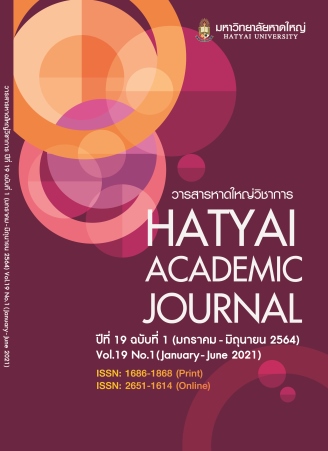A Study of Resilience Factors and Coping Strategies for Adolescent Victims of Cyberbullying
Main Article Content
Abstract
The purposes of this research were 1) to study components of resilience and coping strategies for adolescent victims of cyberbullying and 2) to analyze the confirmatory factors. A semi-structured in-depth interview was used in the study. Nine adolescences who experienced cyberbullying were purposively selected as key informants. The study was conducted through qualitative methodology by an analytic-induction interview. The obtained data was then used to develop questions and the analysis process. Three-hundred high-school students aged between 15-19 years old in Matthayom 4-6 were asked to answer the questions. The LISREL version 8.72 was used to assess the construct validity. With each item ranked between 0.67 and 1.00 of an IOC value, the entire test (all items) was validated with 0.867 and 0.817 reliability values respectively. The validation was conducted with 50 high-school students of the same age-range. It was found that there were three components of resilience: self-consciousness, self-adaptability, and self-recovery ability. Each component was tested with ten questions. The model was therefore coherent with the empirical data and related with the Grotberg Framework and with the resilience quotient (RQ) developed by the Department of Mental Health.
There were two components in coping with the bullying: problem-focused coping strategies and emotion-focused coping strategies. Each component was tested with eight questions. The model then was coherent with the empirical data and related with the Lazarus & Folkman Framework.
Article Details
All published articles are evaluated by three qualified peer reviewers from various institutions through a double-blind process, where reviewers do not know the authors’ identities and authors do not know the reviewers’ identities. The content and articles in the Hatyai Academic Journal reflect the authors’ views only and are neither the opinions of the editorial board nor the responsibility of Hatyai University. The Editorial Board of the Hatyai Academic Journal allows articles to be reproduced for academic purposes, on the condition that the original source is clearly cited.
References
Amaraphibal, A., Rujipak, T., & Payakkakom, A. (2013). A model explaining violent behavior among youth: A case study of middle school students in bangkok. International Journal of Asian Social Science, 3(3), 703-726.
Bourne, E. J. (2010). The anxiety and phobia workbook (5th ed.). CA: New Harbinger.
Campbell, M., Spears, B., Slee, P., Butler, D., & Kift, S. (2012). Victims’ perceptions of traditional and cyberbullying, and the psychosocial correlates of their victimisation. Emotional & Behavioural Difficulties, 17(3/4), 389-401.
Cassmeyer, V. L., Mitchell, P. H., & Betrus, P. A. (1995). Stress, stressor, and stress managetment, In W. J. Phipps, V. L. Cassneeyer, T. K. Sands, M. K. Lehman (Eds.), Medical-surgical nursing: Concepts & Clinecal practice (5th ed., pp. 162-183). Missouri: Mosby Year Book.
Connor, K. M., & Davidson, J. R. T. (2003). Development of a new resilience scale: The Connor-Davidson resilience scale (CD-RISC). Depression and Anxiety, 18(2), 76-82.
Creswell, J. W. (2015). A concise introduction to mixed methods research. Thousand Oaks, CA: Sage Publications.
Department of Mental Health. (2012). The manual of resilience quotient for local mass media. Nonthaburi: Sankid. [in Thai]
Ding, L., Velicer, W. F., & Harlow, L. L. (1995). Effects of estimation methods, number of indicators per factor and improper solutions on structural equation modeling fit indices. Structural Equation Modeling, 2(2), 119-143.
Englander, E. K. (2011). MARC freshman study 2011: Bullying, cyberbullying, risk factors and reporting. Retrieved from http://vc.bridgew.edu/cgi/viewcontent.cgi?article=1000&context=marc_reports
Gilligan, R. (2000). Adversity, resilience and young people: The protective value of positive school and spare time experiences. Children & Society, 14(1), 37-47.
Goodno, N. H. (2007). Cyberstalking, a new crime: Evaluating the effectiveness of current state and federal Laws. Missouri Law Review, 72(1), 125-197.
Grotberg E. H. (1995). A guide to promoting resilience in children: Strengthening the human spirit. Netherlands: The Bernard van Leer Foundation.
Hair, J. F., Black, W. C., Babin, B. J., & Anderson, R. E. (2010). Multivariate data analysis
(7th ed.). New York: Pearson.
Ignatgavicius, D. D., & Bayne, V. M. (1991). Medical-surgical nursing. Philadelphia: W. B. Saunders.
Lazarus, R. S., & Folkman, S. (1984). Stress appraisal and coping. New York: Springer.
Malisuwan, S. (2010). Social networking. Retrieved from https://phatrsa.blogspot.com/2010/09/social-networking.html [in Thai]
Muksikkaphan, W., Pokpong, S., Songsiri, N., & Surat, P. (2009). Behaviors of cyberbullying in youth in Bangkok. Bangkok: The Wisdom Society for Public Opinion Research of Thailand. [in Thai]
O’Brien, N., & Moules, T. (2010). The impact of cyber-bullying on young people’s mental health. Retrieved from http://www.ncb.org.uk/media/111007/cyberbullying_report.pdf
Perren, S., Corcoran, L., Cowie, H., Dehue, F., Garcia, D., Guckin, C. M., Sevcikova, A., Tsatsou, P., & Vollink, T. (2012). Tacking cyberbullying: Review of empirical evidence regarding successful responses by students, parents, and schools. International Journal of Conflict and Violence, 6(2), 283-293.
Pokpong, S., & Muksikkapong, W. (2010). Factors for influencing attitudes and behaviors in physical violence and cyberbullying in youth. Bangkok: Mahidol University. [in Thai]
Smith, P. K., Mahdavi, J., Carvalho, M., Fisher, S., Russell, S., & Tippett, N. (2008). Cyberbullying: Its nature and impact in secondary school pupils. Journal of Child Psychology and Psychiatry, 49(4), 376-385.
Stoltz, P. G. (1997). Adversity quotient: Turning obstacles into opportunities. New York: Johy Wiley & Sons.
The National Statistic Office. (2016). Using information and communication technology in the household. Retrieved from http://service.nso.go.th/nso/web/statseries/statseries22.html [in Thai]
The National Statistic Office. (2018). The 1st quater-2018 information and communication technology survey on household. Retrieved from http://www.nso.go.th/sites/2014/Pages/Survey/InformationTechnology/Technology on Household.aspx [in Thai]
Tokunaga, R. S. (2010). Following you home from school: A critical review and synthesis of research on cyberbullying victimization. Computers in Human Behavior, 26(3), 277-287.
Waaktaar, T., Christie, H. J., Borge, A. I. H., & Torgersen, S. (2004). Building youths resilience within a psychiatric outpatient setting: Result from a pilot clinical intervention project. Psychological Reports, 94(1), 363-370.
Wang, J., Nansel, T. R., & Iannotti, R. J. (2011). Cyber and traditional bullying: Differential association with depression. Journal of Adolescent Health, 48(4), 415-417.

